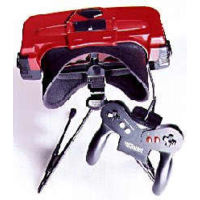Difference between revisions of "Virtual Boy"
WarioFan63 (talk | contribs) |
WarioFan63 (talk | contribs) m |
||
| Line 26: | Line 26: | ||
==Product Failure== | ==Product Failure== | ||
| − | The Virtual Boy was designed by [[Gunpei Yokoi]], who also designed the [[Game & Watch]] series of handhelds as well as the [[ | + | The Virtual Boy was designed by [[Gunpei Yokoi]], who also designed the [[Game & Watch]] series of handhelds as well as the [[Game Boy]]. The Virtual Boy was not intended to replace the Game Boy, due to the need for a steady surface to play it. Yokoi didn't intend for the Virtual Boy to be released in it's present form, but Nintendo got impatient with the amount of time it was taking and rushed to market. |
The system was highly anticipating, with some people suggesting that it might be able to project images into the air above it. The system was a considerable disappointment. | The system was highly anticipating, with some people suggesting that it might be able to project images into the air above it. The system was a considerable disappointment. | ||
Revision as of 16:53, 8 January 2010

| |

| |
| Manufacturer | Nintendo |
| Type | Portable game console |
| Generation | Fifth |
| CPU | NEC V810 |
| Media | Cartridge |
| Controllers | 1 |
| Release Date | JP July 21, 1995 US August 14, 1995 |
| Top Game | Mario's Tennis |
The Virtual Boy was the first system capable of "true 3D graphics." While most consoles depend on perspective to create the three-dimensional space, the Virtual Boy used an effect called parallax to create an illusion of depth. The player would view the red and black image through the Virtual Boy's goggles. Upon release, it sold for US$180. It never achieved much popularity, despite price drops.
Product Failure
The Virtual Boy was designed by Gunpei Yokoi, who also designed the Game & Watch series of handhelds as well as the Game Boy. The Virtual Boy was not intended to replace the Game Boy, due to the need for a steady surface to play it. Yokoi didn't intend for the Virtual Boy to be released in it's present form, but Nintendo got impatient with the amount of time it was taking and rushed to market.
The system was highly anticipating, with some people suggesting that it might be able to project images into the air above it. The system was a considerable disappointment.
There were many factors contributing to the Virtual Boy's ultimate failure:
- The product was rushed to market before it was ready.
- Though it was marketed as a portable system, it wasn't as portable as gamers thought it should be. Using it in motion could cause damage to it.
- At US$180, many people consider the Virtual Boy too expensive.
- Warnings about eyestrain may have scared customers off. Additionally, the Virtual Boy is known to caused headaches if played for too long.
- Only 22 games were released for the Virtual Boy, giving it a very limited library.
- The system could not be adjusted vertically. This meant the system had to be used on a table or on the floor with the player laying down.
- Because of the design of the Virtual Boy, only one player could see what's going on at a time. A multiplayer feature via a link was in the works, but was never completed.
- Due to it's failure in America and Japan, the Virtual Boy was never released in Europe.
Nintendo placed the blame for the Virtual Boy directly on it's creator, Gunpei Yokoi. Not long afterwards, he left Nintendo to found Koto Labs and work on the Wonderswan handheld system.
Legacy
The Virtual Boy is one of the systems on the Trophy Room shelf in Japanese version of Super Smash Bros. Melee. Due to it's failure and the fact it wasn't released in Europe or Australia, it was removed from the English version of the game. However, you can view it in the US release of the game by changing the game's language to Japanese.
In WarioWare, Inc.: Mega Microgame$! one of the microgames is based on Mario Clash, complete with red and black graphics. In WarioWare: Smooth Moves, the Virtual Boy is found in the micro game Sifty Characters. In Pokémon Stadium 2, the Virtual Boy can be viewed in the player's 3D bedroom, along with other consoles like the Nintendo 64 and Super Nintendo.
See Also
External Links
| Nintendo Systems |
|---|
| NES - Super NES - Nintendo 64 - GameCube - Wii - Wii U - Switch Game Boy - Game Boy Color - Game Boy Advance - Nintendo DS (DSi) - 3DS (New 3DS) Arcade - Color TV Game - Game & Watch - Virtual Boy |